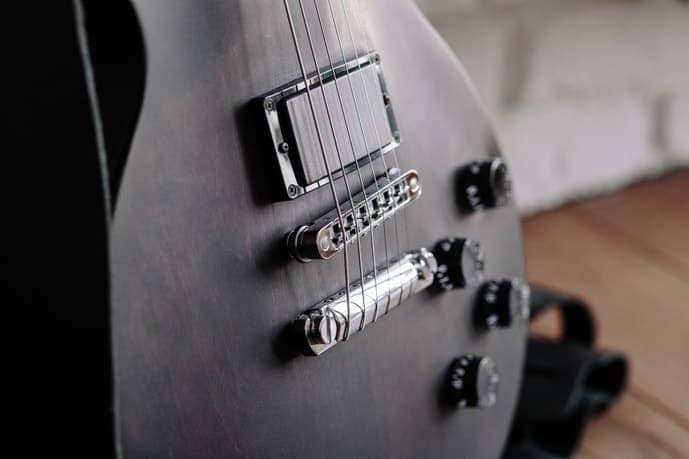
This post is the active pickup guide when it comes to batteries, battery life, and how a dying battery can affect your guitars tone. First let’s answer the main question…
Do active pickups need a battery?
All bass and guitars with active pickups require a 9V battery to power the active preamp located in the electronic housing. The preamp is required to boost the initial low out signal from the guitar cable to be amplified converting the signal to high output.
What Is a Preamp?
A ‘preamp’ as the name suggests, is a ‘pre-amplification’ source that functions to take a weak signal and amplify it to a useable level, commonly known as ‘line level’.
You will find a preamp in nearly every device that captures an audio signal: audio interfaces, microphones, DJ mixers, mobile phones, mixing desks, and of course active pickups to name a few..
The reason why an active preamp requires an external energy source being the 9V battery, in this case, is a simple fact that most amplification sources need
When a battery begins to fail inside your guitar, however, the preamp is going to be short on power which can negatively affect your guitar’s tone.
How a Dying Battery Affects Tone
The ‘clarity’, ‘tone’ and ‘string definition’ when combined with heavy distortion is the reason why active pickups are so favored by metal players.
However, you will be surprised how many players have been bemused and puzzled to how and why their newly purchased or second hand guitar with active pickups sounds so bad.
The first protocol is to blame the brand of pickups and reconsider swapping them out to another make. Only to realize that the solution is actually just a simple battery change to get the guitar singing to its original best.
The clear signs when your active pickups need a battery replacement is when you detect a noticeable drop in ‘signal strength’, ‘gain’ and ‘output’. This is usually when the battery is at about 20% of it’s useable life left.
Tonal Signs When a Battery Needs Replacing
When it comes to tone, you will notice that the sound does not include it’s usual ”drive’, ‘bite’ and ‘output’. This becomes more noticeable when using heavy distortion which is the usual active pickup territory for metal tones.
The tone will also sound ‘fizzy’ and ‘brittle’ with no ‘bottom-end’, this is clear sign that the pre amp is lacking output due to a lack of power.
When it comes to clean, the tones will usually sound distorted excluding any clarity and definition sounding generally ”muddy’ and ‘loose’.
Another giveaway is when rolling the guitars volume up and down, you will hear a subtle ‘crackling’ sound similar to the familiar sound of static.
Although active pickups are known for being virtually silent you may encounter some ‘hum’ or ‘buzzing’, especially when playing through an amp at gigging volumes, which is another sign that the 9V battery needs replacing.
So to recap you will notice….
- Drop in volume
- Drop in output
- Drop in gain
- Fizzy tone
- Lack of punch and drive
- Distorted clean tones
- Crackling when adjusting the guitars volume knob.
- Unexpected hum and buzz
If you want to hear an example of what I have just explained, this video demonstrates the differences in sound and tone between a guitar using a fresh battery and a flat battery. The differences are drastic! (Watch below)
How Often Should You Replace the Battery?
This is a subjective answer because every guitar player will use their guitar more than other players. A heavy touring and session musician is going to use their guitar more than a on the side hobbyist.
When to change also comes to personal choice. The first obvious answer is to change the battery when the guitar starts to experience the negative tonal symptoms I just mentioned above. Low output, lack of bite, lack of gain, thin tone etc.
When to change a healthy battery, however, will depend on how much you use your guitar and the amount of battery life you have available.
My Reccomendation
A good standard I like to run with is replacing the battery every 2-4 months. Even up to 6 months if you wish!
Another guide I have heard is changing the battery around every 1000 hours of playing.
However, the problem with this is that 99% of guitar players are not going to log their playing hours like a commercial pilot. So going off the last time the battery was replaced and keeping close tabs on how the guitar sounds is going to be the best protocol.
Using your ears, common sense and keeping on top of the battery is the best thing to do to ensure a well-fed and happy preamp.
Personally I would change the battery before every gig or studio session ensuring I give my instrument the best chance of performing at its best when it comes to producing the best tone and sound.
If your guitar was built with active pickups as stock, it should contain a compartment at the back of the body for easy access for swapping the 9V battery.
How to Improve Battery Life
Let’s say you are playing some crazy ‘shredding’ and ‘chugging’ on your custom Ibanez with a set of EMGs installed, when all of a sudden your friend calls and you need to answer the phone.
Instead of turning the amp on standby and setting the guitar aside while talking to your friend for hours.
The best thing to do to preserve battery life, is unplugging your guitar when it is not in use as remember, turning the amp on standby is not enough.
As soon as the lead is connected to a guitar with active pickups ,the preamp housed inside is activated and slowly draining your precious battery time without a single note played.
The reason is because as soon as the cable is connected you have ‘completed the circuit’, meaning you are draining the battery regardless if you are playing the guitar or not.
So always unplug the guitar when it is not in use to help get the most out of your batteries. The battery time you wasted could have been used for making or playing sweet music.
If you decide to stick to with using disposable batteries then always go with the top brand to ensure the best energy source for your instrument. I can’t say for definite that using a cheap disposable 9V battery will be the same as a high-end brand.
But for me personally, I would rather spend the best power source for my instrument to get the best tone available. Using a high end brand will also ensure the longest battery life for my active pickups.
However you can always go the alternative route which brings me to my next point…
Disposable or Rechargeable Batteries?
So what type of 9V battery should you go for? Although buying a multi-pack of cheap disposable batteries may save you more in the short term and be slightly more convenient as you can pick them up from any store.
Rechargeable 9V batteries on the other hand, will save you more in the long term and includes the benefit of being more environmentally friendly.
The rechargeable option can last for many years undergoing up to 500 charges. Keep in mind, each single full charge will give you slightly less battery life as they will degrade over time.
Charge them up before a show, studio time or a heavy session drop them in and be safe in the knowledge that you have full charged battery ready to play on full power.
It is also saving you money in the long term and it is a kinder option for the environment. Whatever option you choose however comes to personal preference.
Related Questions
Does storing an active pickup guitar for a long time waste battery?
Only when the guitar cable is plugged in the active pre amp will be using battery life. Therefore, storing a guitar for a long time without plugging it in will not waste any energy. It will still have the same amount of charge as the last time it was played.
Do passive pickups need a battery?
Passive pickups do not require a 9V battery as there is no active preamp or amplification within the guitars electronics. A guitar with passive pickups rely on an external amplification source to boost the signal for more gain such as a guitar amp, distortion pedals, booster pedals etc.
